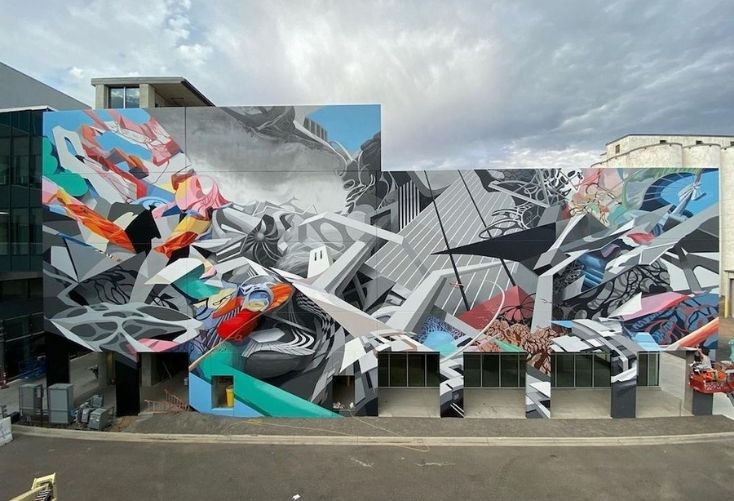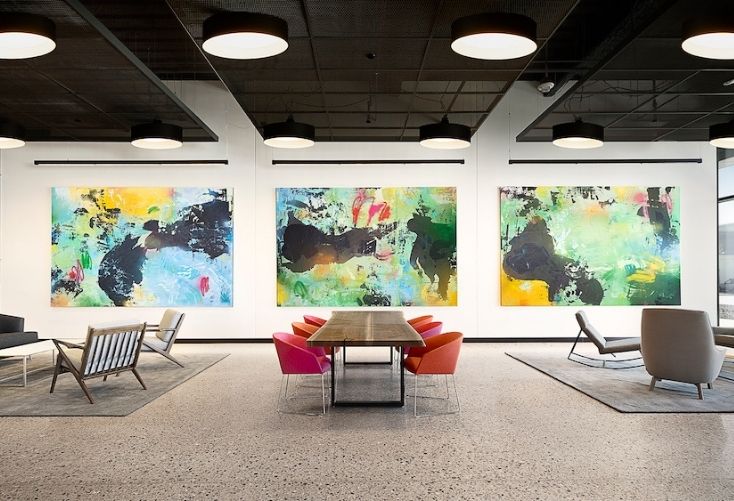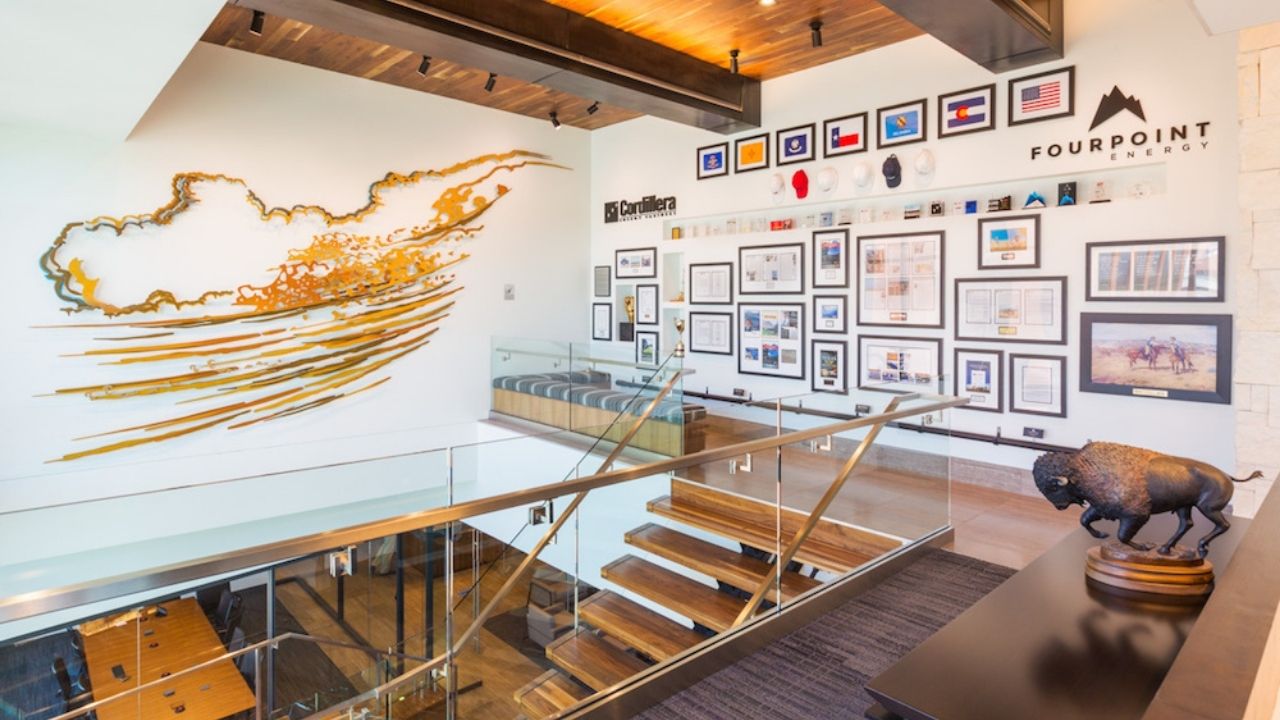- The vast majority of people say that art installations elicit positive feedback. Why not make your space stand out?
- Office buildings are full of underutilized areas, but when reimagined can become functional and flattering.
- Large-scale art draws your employees, partners and visiting clients’ attention and extends an invitation to explore and discover.
This article was originally published on Work Design Magazine.
There are several underutilized areas within an office building, but when reimagined you can make it functional and flattering.
This is where day-to-day work life happens – small talk, coffee breaks, office celebrations. They are the elevators, the parking garages, the outdoor patios, the front vestibule. The heartbeat of the modern office space, where meaningful connections are made amongst co-workers.
Each of these individual environments are part of the office ecosystem, yet for many organizations, these spaces are merely an afterthought.
The rise of outdoor spaces is a swiftly growing trend in art. Utilizing outdoor spaces and uncommon areas to provide captivating and forward-thinking experiences can encourage a renewed affinity for brands, foster innovation and create a sense of well-being.

Large-Scale Art is Inviting
The vast majority of people say that art installations elicit positive feedback. Why not make your space stand out? Large-scale art draws your employees, partners and visiting clients’ attention and extends an invitation to explore and discover.
Big art enables individuals and groups to take in an artistic experience in a safe environment. Art from afar allows for maximum impact at a distance. Viewers can take in creative expression without having to necessarily be near the art or other people.
Workspaces who want to utilize large-scale art installations should consider outdoor areas as blank canvases. Exterior walls, parking garages and even outward facing elevators are prime backgrounds for big format installations or murals.
What does this look like in practice?
- Jackson National Life combines traditional office space and immersive art experiences featuring natural elements to elevate the workplace and stimulate creativity among employees.
- Rev360 embraces the Denver-based RiNo neighborhood’s grittiness and industrial background with multiple exterior murals by Oliver Vernon, including a landmark defining installation on the building’s north side and another on the garage. Both experiences help identify the multi-use facility and office space as a unique element within the area.
These and other projects like them utilize often forgotten spaces to tell the rich history of a location and create conversation for employees and guests alike.

Large-Scale Art Builds Brand
Almost two-thirds of people say it’s absolutely critical that art expresses brand, mission and vision. After all, art is your brand in visual form. When done correctly, an art experience is a curated narrative of your company. So why keep it behind closed doors?
Outdoor, large-scale art creates a sense of place with impossible-to-miss landmarks. They serve as unexpected way finders and create moments connected to your brand. They promote a sense of community and bolster quality of life for your employees and visitors.
When creating art experiences, consider who you are as an organization. Think through your company’s past and present, the values you stand for and your mission for the future. Then, find ways to take those passions and interpret them into a visual experience.
For instance, Denver Water set out to share their story and the value of water through public art. They sought to educate onlookers and employees to dive into how Denver gets their water. To do this, the organization created three unique installations with the goal of educating the public about the value of water.
One of the signature pieces is called “Forests to Faucets” and can be found in an open courtyard. The piece was crafted with a local artist and the help of several employees for Denver Water who focused on the journey of Denver’s water through the mountains and into city faucets.

Large-Scale Art Can Bring the Outdoors In
There is beauty in the outdoors. Many find a sense of calm and tranquility in nature. Biophilic design, the art of connecting people and nature within our built environments and communities, offers a name to this intentional design practice.
As we transition into the office setting again, how can your organization bring the outdoors in? Utilizing art to create unique spaces that harness the advantages of the outdoors and make them a reality in your corporate setting.
Choose nature-themed pieces to create a sense of place
It is possible to create a sense of energy in an art collection. Take Fourpoint Energy. As a brand built on energy exploration, they wanted to create a location that portrayed the relationship between art and science. Their work in nature directly inspired the pieces displayed in their facility. A four-hundred pound hand-forged steel and bronze sculpture depicts the compression of tectonic plates in the main lobby. A focal wall near a staircase features a piece called “Metamorphic Current ” which distills geologic history and processes into a large-scale wall relief sculpture.

Use both indoor and outdoor spaces to branch out from the traditional office space
Jackson National Life’s headquarters building is home to 1,384 artworks spread throughout two buildings. The collection includes both exterior and interior art-activated spaces designed to engage visitors and employees.
For instance, large floor-to-ceiling windows accompany common seating areas. The natural light and calming forest backdrop help stimulate creativity and dialogue for employees. Dramatic and dynamic sculptures adorn outdoor common spaces, giving a wow factor to the exterior of the headquarters facility.


 Dr. Gleb Tsipursky – The Office Whisperer
Dr. Gleb Tsipursky – The Office Whisperer Nirit Cohen – WorkFutures
Nirit Cohen – WorkFutures Angela Howard – Culture Expert
Angela Howard – Culture Expert Drew Jones – Design & Innovation
Drew Jones – Design & Innovation Jonathan Price – CRE & Flex Expert
Jonathan Price – CRE & Flex Expert













